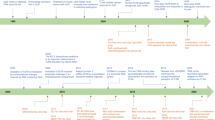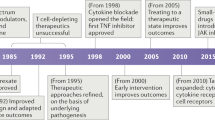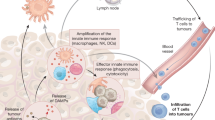Abstract
The identification of the antigen recognition receptors for innate immunity, most notably the Toll-like receptors, has sparked great interest in therapeutic manipulation of the innate immune system. Toll-like receptor agonists are being developed for the treatment of cancer, allergies and viral infections, and as adjuvants for potent new vaccines to prevent or treat cancer and infectious diseases. As recognition grows of the role of inappropriate Toll-like receptor stimulation in inflammation and autoimmunity, significant efforts have begun to develop antagonists to Toll-like receptors as well.
This is a preview of subscription content, access via your institution
Access options
Subscribe to this journal
Receive 12 print issues and online access
$209.00 per year
only $17.42 per issue
Buy this article
- Purchase on Springer Link
- Instant access to full article PDF
Prices may be subject to local taxes which are calculated during checkout

Kim Caesar
Similar content being viewed by others
References
Janeway, C.A. Jr. How the immune system works to protect the host from infection: a personal view. Proc. Natl. Acad. Sci. USA 98, 7461–7468 (2001).
Janeway, C.A. Jr. & Medzhitov, R. Innate immune recognition. Annu. Rev. Immunol. 20, 197–216 (2002).
Sansonetti, P.J. The innate signaling of dangers and the dangers of innate signaling. Nat. Immunol. 7, 1237–1242 (2006).
Meylan, E., Tschopp, J. & Karin, M. Intracellular pattern recognition receptors in the host response. Nature 442, 39–44 (2006).
Akira, S., Uematsu, S. & Takeuchi, O. Pathogen recognition and innate immunity. Cell 124, 783–801 (2006).
Hoebe, K. et al. TLR signaling pathways: opportunities for activation and blockade in pursuit of therapy. Curr. Pharm. Des. 12, 4123–4134 (2006).
Lemaitre, B., Nicolas, E., Michaut, L., Reichhart, J.M. & Hoffmann, J.A. The dorsoventral regulatory gene cassette spatzle/Toll/cactus controls the potent antifungal response in Drosophila adults. Cell 86, 973–983 (1996).
Hoffmann, J.A. The immune response of Drosophila. Nature 426, 33–38 (2003).
Medzhitov, R., Preston-Hulburt, P. & Janeway, C.A. A human homologue of the Drosophila Toll protein signals activation of adaptive immunity. Nature 388, 394–397 (1997).
Roach, J.C. et al. The evolution of vertebrate Toll-like receptors. Proc. Natl. Acad. Sci. USA 102, 9577–9582 (2005).
Rock, F.L., Hardiman, G., Timans, J.C., Kastelein, R.A. & Bazan, J.F. A family of human receptors structurally related to Drosophila Toll. Proc. Natl. Acad. Sci. USA 95, 588–593 (1998).
Rast, J.P., Smith, L.C., Loza-Coll, M., Hibino, T. & Litman, G.W. Genomic insights into the immune system of the sea urchin. Science 314, 952–956 (2006).
Choe, J., Kelker, M.S. & Wilson, I.A. Crystal structure of human toll-like receptor 3 (TLR3) ectodomain. Science 309, 581–585 (2005).
Bell, J.K. et al. The molecular structure of the Toll-like receptor 3 ligand-binding domain. Proc. Natl. Acad. Sci. USA 102, 10976–10980 (2005).
Akira, S. & Hemmi, H. Recognition of pathogen-associated molecular patterns by TLR family. Immunol. Lett. 85, 85–95 (2003).
Latz, E. et al. TLR9 signals after translocating from the ER to CpG DNA in the lysosome. Nat. Immunol. 5, 190–198 (2004).
Lee, J. et al. Maintenance of colonic homeostasis by distinctive apical TLR9 signalling in intestinal epithelial cells. Nat. Cell Biol. 8, 1327–1336 (2006).
Akira, S. & Takeda, K. Toll-like receptor signalling. Nat. Rev. Immunol. 4, 499–511 (2004).
Marshak-Rothstein, A. Toll-like receptors in systemic autoimmune disease. Nat. Rev. Immunol. 6, 823–835 (2006).
Hasan, U. et al. Human TLR10 is a functional receptor, expressed by B cells and plasmacytoid dendritic cells, which activates gene transcription through MyD88. J. Immunol. 174, 2942–2950 (2005).
Krieg, A.M. Therapeutic potential of Toll-like receptor 9 activation. Nat. Rev. Drug Discov. 5, 471–484 (2006).
Tomai, M.A., Miller, R.L., Lipson, K.E., Vasilakos, J.P. & Woulfe, S.L. Immune response modifiers: Imiquimod and future drugs for modulating the immune response. Drug Discov. Today Ther. Strateg. [online] 3, 342–352 (2006).
Lee, J. et al. Molecular basis for the immunostimulatory activity of guanine nucleoside analogs: activation of Toll-like receptor 7. Proc. Natl. Acad. Sci. USA 100, 6646–6651 (2003).
Evans, J.T. et al. Enhancement of antigen-specific immunity via the TLR4 ligands MPL adjuvant and Ribi.529. Expert Rev. Vaccines 2, 219–229 (2003).
Alexopoulou, L., Holt, A.C., Medzhitov, R. & Flavell, R.A. Recognition of double-stranded RNA and activation of NF-kappaB by Toll-like receptor 3. Nature 413, 732–738 (2001).
Gay, N.J., Gangloff, M. & Weber, A.N. Toll-like receptors as molecular switches. Nat. Rev. Immunol. 6, 693–698 (2006).
Moynagh, P.N. TLR signalling and activation of IRFs: revisiting old friends from the NF-κB pathway. Trends Immunol. 26, 469–476 (2005).
Stetson, D.B. & Medzhitov, R. Type I interferons in host defense. Immunity 25, 373–381 (2006).
Honda, K., Takaoka, A. & Taniguchi, T. Type I interferon [corrected] gene induction by the interferon regulatory factor family of transcription factors. Immunity 25, 349–360 (2006).
Iwasaki, A. & Medzhitov, R. Toll-like receptor control of the adaptive immune responses. Nat. Immunol. 5, 987–995 (2004).
Hornef, M.W. & Bogdan, C. The role of epithelial Toll-like receptor expression in host defense and microbial tolerance. J. Endotoxin Res. 11, 124–128 (2005).
Hayashi, F., Means, T.K. & Luster, A.D. Toll-like receptors stimulate human neutrophil function. Blood 102, 2660–2669 (2003).
Butcher, E.C., Williams, M., Youngman, K., Rott, L. & Briskin, M. Lymphocyte trafficking and regional immunity. Adv. Immunol. 72, 209–253 (1999).
Han, J. & Ulevitch, R.J. Limiting inflammatory responses during activation of innate immunity. Nat. Immunol. 6, 1198–1205 (2005).
Steinman, R.M. & Hemmi, H. Dendritic cells: translating innate to adaptive immunity. Curr. Top. Microbiol. Immunol. 311, 17–58 (2006).
Pulendran, B. & Ahmed, R. Translating innate immunity into immunological memory: implications for vaccine development. Cell 124, 849–863 (2006).
Banchereau, J. & Steinman, R.M. Dendritic cells and the control of immunity. Nature 392, 245–252 (1998).
Kawai, T. & Akira, S. Innate immune recognition of viral infection. Nat. Immunol. 7, 131–137 (2006).
Colonna, M., Trinchieri, G. & Liu, Y.J. Plasmacytoid dendritic cells in immunity. Nat. Immunol. 5, 1219–1226 (2004).
Krieg, A.M., Efler, S.M., Wittpoth, M., Al Adhami, M.J. & Davis, H.L. Induction of systemic TH1-like innate immunity in normal volunteers following subcutaneous but not intravenous administration of CPG 7909, a synthetic B-class CpG oligodeoxynucleotide TLR9 agonist. J. Immunother. 27, 460–471 (2004).
Rakoff-Nahoum, S., Paglino, J., Eslami-Varzaneh, F., Edberg, S. & Medzhitov, R. Recognition of commensal microflora by toll-like receptors is required for intestinal homeostasis. Cell 118, 229–241 (2004).
Katakura, K. et al. Toll-like receptor 9-induced type I IFN protects mice from experimental colitis. J. Clin. Invest. 115, 695–702 (2005).
Datta, S.K., Cho, H.J., Takabayashi, K., Horner, A.A. & Raz, E. Antigen-immunostimulatory oligonucleotide conjugates: mechanisms and applications. Immunol. Rev. 199, 217–226 (2004).
Dupont, J. et al. A controlled clinical trial comparing the safety and immunogenicity of a new adjuvanted hepatitis B vaccine with a standard hepatitis B vaccine. Vaccine 24, 7167–7174 (2006).
Halperin, S.A. et al. Comparison of the safety and immunogenicity of hepatitis B virus surface antigen co-administered with an immunostimulatory phosphorothioate oligonucleotide and a licensed hepatitis B vaccine in healthy young adults. Vaccine 24, 20–26 (2006).
Harper, D.M. et al. Sustained efficacy up to 4.5 years of a bivalent L1 virus-like particle vaccine against human papillomavirus types 16 and 18: follow-up from a randomised control trial. Lancet 367, 1247–1255 (2006).
Rock, K.L. & Shen, L. Cross-presentation: underlying mechanisms and role in immune surveillance. Immunol. Rev. 207, 166–183 (2005).
Hodi, F.S. & Dranoff, G. Combinatorial cancer immunotherapy. Adv. Immunol. 90, 341–368 (2006).
Speiser, D.E. et al. Rapid and strong human CD8+ T cell responses to vaccination with peptide, IFA, and CpG oligodeoxynucleotide 7909. J. Clin. Invest. 115, 739–746 (2005).
Krieg, A.M. Antitumor applications of stimulating toll-like receptor 9 with CpG oligodeoxynucleotides. Curr. Oncol. Rep. 6, 88–95 (2004).
Zaks, K. et al. Efficient immunization and cross-priming by vaccine adjuvants containing TLR3 or TLR9 agonists complexed to cationic liposomes. J. Immunol. 176, 7335–7345 (2006).
Cho, H.J. et al. Immunostimulatory DNA-based vaccines induce cytotoxic lymphocyte activity by a T-helper cell-independent mechanism. Nat. Biotechnol. 18, 509–514 (2000).
Wille-Reece, U. et al. HIV Gag protein conjugated to a Toll-like receptor 7/8 agonist improves the magnitude and quality of Th1 and CD8+ T cell responses in nonhuman primates. Proc. Natl. Acad. Sci. USA 102, 15190–15194 (2005).
Yarovinsky, F., Kanzler, H., Hieny, S., Coffman, R.L. & Sher, A. Toll-like receptor recognition regulates immunodominance in an antimicrobial CD4+ T cell response. Immunity 25, 655–664 (2006).
Blander, J.M. & Medzhitov, R. On regulation of phagosome maturation and antigen presentation. Nat. Immunol. 7, 1029–1035 (2006).
Butts, C. et al. Randomized phase IIB trial of BLP25 liposome vaccine in stage IIIB and IV non-small-cell lung cancer. J. Clin. Oncol. 23, 6674–6681 (2005).
Marshall, J.D. et al. Polymyxin B enhances ISS-mediated immune responses across multiple species. Cell. Immunol. 229, 93–105 (2004).
Storni, T. et al. Critical role for activation of antigen-presenting cells in priming of cytotoxic T cell responses after vaccination with virus-like particles. J. Immunol. 168, 2880–2886 (2002).
Horner, A.A., Redecke, V. & Raz, E. Toll-like receptor ligands: hygiene, atopy and therapeutic implications. Curr. Opin. Allergy Clin. Immunol. 4, 555–561 (2004).
Racila, D.M. & Kline, J.N. Perspectives in asthma: molecular use of microbial products in asthma prevention and treatment. J. Allergy Clin. Immunol. 116, 1202–1205 (2005).
Tulic, M.K. et al. Amb a 1-immunostimulatory oligodeoxynucleotide conjugate immunotherapy decreases the nasal inflammatory response. J. Allergy Clin. Immunol. 113, 235–241 (2004).
Creticos, P.S. et al. Immunotherapy with a ragweed-toll-like receptor 9 agonist vaccine for allergic rhinitis. N. Engl. J. Med. 355, 1445–1455 (2006).
Bochner, B.S. & Busse, W.W. Allergy and asthma. J. Allergy Clin. Immunol. 115, 953–959 (2005).
Larche, M. Immunoregulation by targeting T cells in the treatment of allergy and asthma. Curr. Opin. Immunol. 18, 745–750 (2006).
Julia, V. et al. A restricted subset of dendritic cells captures airborne antigens and remains able to activate specific T cells long after antigen exposure. Immunity 16, 271–283 (2002).
Gauvreau, G.M. et al. Immunostimulatory sequences regulate interferon-inducible genes but not allergic airway responses. Am. J. Respir. Crit. Care Med. 174, 15–20 (2006).
Moisan, J. et al. TLR7 ligand prevents allergen-induced airway hyperresponsiveness and eosinophilia in allergic asthma by a MYD88-dependent and MK2-independent pathway. Am. J. Physiol. Lung Cell. Mol. Physiol. 290, L987–L995 (2006).
Serebrisky, D. et al. CpG oligodeoxynucleotides can reverse Th2-associated allergic airway responses and alter the B7.1/B7.2 expression in a murine model of asthma. J. Immunol. 165, 5906–5912 (2000).
Kline, J.N. et al. CpG oligodeoxynucleotides do not require TH1 cytokines to prevent eosinophilic airway inflammation in a murine model of asthma. J. Allergy Clin. Immunol. 104, 1258–1264 (1999).
Hessel, E.M. et al. Immunostimulatory oligonucleotides block allergic airway inflammation by inhibiting Th2 cell activation and IgE-mediated cytokine induction. J. Exp. Med. 202, 1563–1573 (2005).
Fanucchi, M.V. et al. Immunostimulatory oligonucleotides attenuate airways remodeling in allergic monkeys. Am. J. Respir. Crit. Care Med. 170, 1153–1157 (2004).
Coffman, R.L. & Hessel, E.M. Nonhuman primate models of asthma. J. Exp. Med. 201, 1875–1879 (2005).
Tayyari, F., Sutton, T.C., Manson, H.E. & Hegele, R.G. CpG-oligodeoxynucleotides inhibit RSV-enhanced allergic sensitisation in guinea pigs. Eur. Respir. J. 25, 295–302 (2005).
Chang, Y.C., Madkan, V., Cook-Norris, R., Sra, K. & Tyring, S. Current and potential uses of imiquimod. South. Med. J. 98, 914–920 (2005).
Jahrsdorfer, B. et al. Immunostimulatory oligodeoxynucleotides induce apoptosis of B cell chronic lymphocytic leukemia cells. J. Leukoc. Biol. 77, 378–387 (2005).
Salaun, B., Coste, I., Rissoan, M.C., Lebecque, S.J. & Renno, T. TLR3 can directly trigger apoptosis in human cancer cells. J. Immunol. 176, 4894–490 1 (2006).
Gekeler, V. et al. G3139 and other CpG-containing immunostimulatory phosphorothioate oligodeoxynucleotides are potent suppressors of the growth of human tumor xenografts in nude mice. Oligonucleotides 16, 83–93 (2006).
Fletcher, S., Steffy, K. & Averett, D. Masked oral prodrugs of toll-like receptor 7 agonists: a new approach for the treatment of infectious disease. Curr. Opin. Investig. Drugs 7, 702–708 (2006).
Klinman, D.M. Immunotherapeutic uses of CpG oligodeoxynucleotides. Nat. Rev. Immunol. 4, 249–258 (2004).
Amlie-Lefond, C. et al. Innate immunity for biodefense: a strategy whose time has come. J. Allergy Clin. Immunol. 116, 1334–1342 (2005).
Rossignol, D.P. & Lynn, M. TLR4 antagonists for endotoxemia and beyond. Curr. Opin. Investig. Drugs 6, 496–502 (2005).
Wang, T. et al. Toll-like receptor 3 mediates West Nile virus entry into the brain causing lethal encephalitis. Nat. Med. 10, 1366–1373 (2004).
Boasso, A. et al. HIV-1 inhibits CD4+ T cell proliferation by inducing indoleamine 2,3-dioxygenase in plasmacytoid dendritic cells. Blood 109, 3351–3359 (2007).
Hooks, J.J. et al. Immune interferon in the circulation of patients with autoimmune disease. N. Engl. J. Med. 301, 5–8 (1979).
Bennett, L. et al. Interferon and granulopoiesis signatures in systemic lupus erythematosus blood. J. Exp. Med. 197, 711–723 (2003).
Baechler, E.C. et al. Interferon-inducible gene expression signature in peripheral blood cells of patients with severe lupus. Proc. Natl. Acad. Sci. USA 100, 2610–2615 (2003).
Baccala, R., Hoebe, K., Kono, D.H., Beutler, B. & Theofilopoulos, A.N. Toll-like receptor-dependent and-independent pathways of type I interferon induction in systemic autoimmunity. Nat. Med. 13, 543–551 (2007).
Ronnblom, L. & Alm, G.V. Systemic lupus erythematosus and the type I interferon system. Arthritis Res. Ther. 5, 68–75 (2003).
Van Ghelue, M., Moens, U., Bendiksen, S. & Rekvig, O.P. Autoimmunity to nucleosomes related to viral infection: a focus on hapten-carrier complex formation. J. Autoimmun. 20, 171–182 (2003).
Lund, J., Sato, A., Akira, S., Medzhitov, R. & Iwasaki, A. Toll-like receptor 9-mediated recognition of Herpes simplex virus-2 by plasmacytoid dendritic cells. J. Exp. Med. 198, 513–520 (2003).
Diebold, S.S., Kaisho, T., Hemmi, H., Akira, S. & Reis e Sousa, C. Innate antiviral responses by means of TLR7-mediated recognition of single-stranded RNA. Science 303, 1529–1531 (2004).
Barrat, F.J. et al. Nucleic acids of mammalian origin can act as endogenous ligands for Toll-like receptors and may promote systemic lupus erythematosus. J. Exp. Med. 202, 1131–1139 (2005).
Means, T.K. et al. Human lupus autoantibody-DNA complexes activate DCs through cooperation of CD32 and TLR9. J. Clin. Invest. 115, 407–417 (2005).
Vollmer, J. et al. Immune stimulation mediated by autoantigen binding sites within small nuclear RNAs involves Toll-like receptors 7 and 8. J. Exp. Med. 202, 1575–1585 (2005).
Lenert, P.S. Targeting Toll-like receptor signaling in plasmacytoid dendritic cells and autoreactive B cells as a therapy for lupus. Arthritis Res. Ther. 8, 203 (2006).
Barton, G.M., Kagan, J.C. & Medzhitov, R. Intracellular localization of Toll-like receptor 9 prevents recognition of self DNA but facilitates access to viral DNA. Nat. Immunol. 7, 49–56 (2006).
Jiang, D. et al. Regulation of lung injury and repair by Toll-like receptors and hyaluronan. Nat. Med. 11, 1173–1179 (2005).
Mollen, K.P. et al. Emerging paradigm: toll-like receptor 4-sentinel for the detection of tissue damage. Shock 26, 430–437 (2006).
Acknowledgements
We thank T. Matray for critical reading of the manuscript and J. Carroll for help with research on the status of clinical programs.
Author information
Authors and Affiliations
Ethics declarations
Competing interests
H.K., F.J.B., E.M.H. and R.L.C. are employees of Dynavax Technologies, a company that is developing products targeting TLR9 to treat or prevent allergies, infectious diseases, cancer and autoimmunity.
Rights and permissions
About this article
Cite this article
Kanzler, H., Barrat, F., Hessel, E. et al. Therapeutic targeting of innate immunity with Toll-like receptor agonists and antagonists. Nat Med 13, 552–559 (2007). https://doi.org/10.1038/nm1589
Published:
Issue Date:
DOI: https://doi.org/10.1038/nm1589
This article is cited by
-
Rewiring innate and adaptive immunity with TLR9 agonist to treat osteosarcoma
Journal of Experimental & Clinical Cancer Research (2023)
-
TLR7 Agonists Modulate the Activation of Human Conjunctival Epithelial Cells Induced by IL-1β via the ERK1/2 Signaling Pathway
Inflammation (2023)
-
Emerging role of RNA sensors in tumor microenvironment and immunotherapy
Journal of Hematology & Oncology (2022)
-
Phytochemicals targeting Toll-like receptors 4 (TLR4) in inflammatory bowel disease
Chinese Medicine (2022)
-
PA-MSHA induces inflamed tumor microenvironment and sensitizes tumor to anti-PD-1 therapy
Cell Death & Disease (2022)



